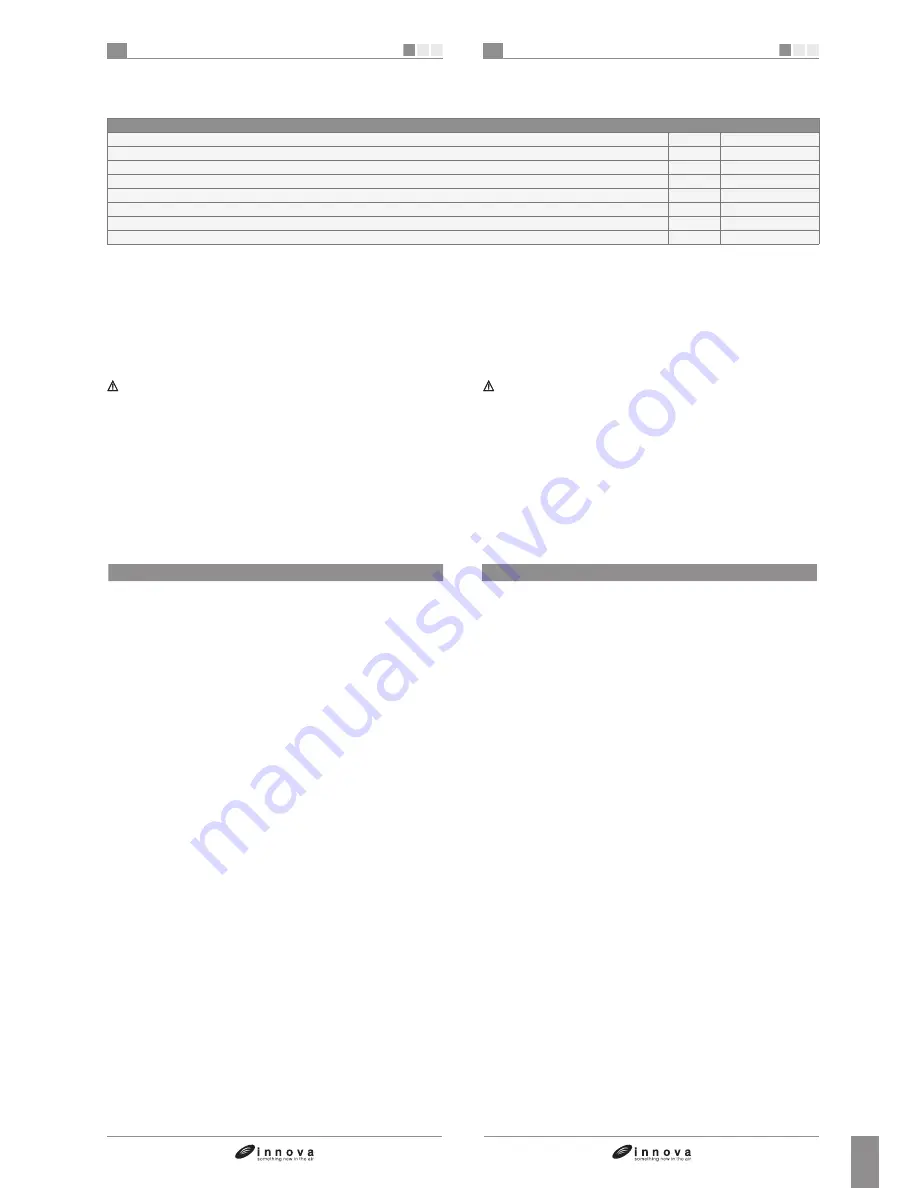
EN
IT
17
INSTALLAZIONE
INSTALLATION
S
S
I
I
U
U
Valori di riferimento acqua impianto / Reference values of system’s water
pH / pH
6,5 ÷ 7,8
Conducibilità elettrica / Electric conductivity
µS/cm
250 ÷ 800
Durezza totale / Total hardness
°F
5 ÷ 20
Ferro totale / Total iron
ppm
0,2
Manganese / Manganese
ppm
< 0,05
Cloruri / Chlorides
ppm
< 250
Ioni zolfo / Sulphur ions
assenti / absent
Ioni ammoniaca / Ammonium ions
assenti / absent
Se la durezza totale è superiore ai 20°F o alcuni valori di riferimento
dell’acqua di reintegro non rientrano nei limiti indicati contattare il nostro
servizio prevendita per determinare i trattamenti da implementare.
Acque di pozzo o falda non provenienti da acquedotto vanno sempre
analizzate attentamente e in caso condizionate con opportuni sistemi di
trattamento. In caso di installazione di un addolcitore oltre a seguire le
prescrizioni del costruttore, regolare la durezza dell’acqua d’uscita non
al di sotto dei 5°F (effettuando altresì i test di pH e di salinità) e verificare
la concentrazione di cloruri in uscita dopo la rigenerazione delle resine.
Attenzione non introdurre acidi all’interno del circuito di lavaggio.
Se l’unità interna è installata all’esterno o in un locale dove la temperatura
può scendere sotto 0°C svuotare l’impianto o introdurvi del liquido
antigelo in una percentuale congrua alle temperature minime raggiungibili.
Soluzioni di acqua e glicole etilenico usate come fluido termovettore in
luogo di acqua, provocano una diminuzione delle prestazioni delle unità.
Addizionare l’acqua con una percentuale massima del 35% di glicole
etilenico (pari ad una protezione fino a -20°C).
Una volta terminati i collegamenti idraulici occorre procedere al
riempimento dell’impianto. Contemporaneamente a questo è necessario
sfiatare l’aria all’interno delle tubazioni e dell’apparecchio.
Durante tutte queste operazioni la macchina deve essere scollegata dalla
rete di alimentazione elettrica.
Se viene utilizzata una pompa ausiliaria esterna la stessa deve essere
spenta.
La pressione di esercizio dell’impianto non deve superare gli 1,5 BAR a
pompa spenta. In ogni caso per verificare eventuali perdite dell’impianto
all’atto del collaudo si consiglia di alzare la pressione di test per poi
scaricarlo successivamente per raggiungere la pressione di esercizio.
Se viene superata la pressione di 3 bar la valvola di sicurezza si apre e
scarica all’esterno l’acqua in esubero. Collegare una tubazione di scarico
alla valvola di sicurezza in modo da evitare che eventuali fuoriuscite
d’acqua vadano a contatto con le parti elettriche dell’apparecchio.
Una volta terminati gli allacciamenti elettrici ed attivata la pompa di
circolazione verificare che non siano ancora presenti residui d’aria. Se
questo dovesse accadere bisogna fermare a più riprese la pompa e
sfiatare nuovamente. Per evitare pericolose cavitazione che potrebbero
danneggiare la pompa e rendere meno efficiente l’intero apparecchio,
la pressione di aspirazione, con pompa accesa, misurabile mediante il
manometro presente sull’apparecchio, non deve essere inferiore a 0,6
BAR.
Once the hydraulic connections have been completed the system will
have to be filled. It will then be necessary to simultaneously release the
air from the inside of the pipes and device itself.
During these operations, the machine must be disconnected from the
mains power supply.
If an external auxiliary pump is used it must also be switched off.
The working pressure of the system must not exceed 1.5bar with the
pump switched off. To check any possible leaks from the system when
setting up we suggest you increase the test pressure and then reduce it
successively it to reach the working pressure.
If the water pressure exceeds 3 bar the safety valve opens and
discharges the water. Connect a drain pipe to water safety valve so as to
prevent that some water leakage can get inside electrical parts.
Once all the electrical connections have been made and the circulation
pump is activated, check that there are no pockets of air in the system.
If this happens, stop the pump, release the air and re-start, repeating
the procedure until it is all cleared. To avoid dangerous cavitations that
could damage the pump and make the entire system less efficient, the
inlet pressure with the pump switched on must not be less than 0,6 bar,
measurable with the manometer on the device.
If the total hardness is above 20°F or some of the make-up water
reference values are not within the indicated limits, contact our pre-sales
service to determine the treatments to be used.
Bore or groundwater not from water supply system should always be
carefully analysed and if necessary treated with appropriate systems. If
installing a softener, in addition to following the manufacturer’s guidelines,
adjust the hardness of the outlet water to no lower than 5°F (also run pH
and salinity tests) and check the concentration of chlorides at outlet after
regeneration of resins.
Warning: do not introduce acids into the wash circuit.
In the case of possible freezing, empty the system and introduce an
antifreeze liquid in a proportion that is appropriate for the minimum
temperatures that can be reached.
Solutions of water and ethylene glycol used as heat-transfer liquids in
place of water cause a reduction in the performance of the unit. Add a
maximum of 35% of ethylene glycol (protection equivalent to as low as
-20°C) to the water.
2.6
Filling the system
2.6
Riempimento impianto
In fase di primo avviamento, il tecnico specializzato dovrà rilevare i valori
di riferimento dell’acqua dell’impianto con degli appositi test kit.
Upon initial start-up, the specialized technician will have to obtain the
reference values of the system’s water using appropriate test kits.
Содержание eHPoca
Страница 1: ...something new in the air Manuale d installazione Installation manual ehpoca 7 9 12 15 18...
Страница 45: ...EN IT 45 informazioni TECNICHE TecHnical specifications S S I I U U...
Страница 46: ...EN IT 46 informazioni TECNICHE TecHnical specifications S S I I U U...
Страница 47: ...EN IT 47 informazioni TECNICHE TecHnical specifications S S I I U U...
















































